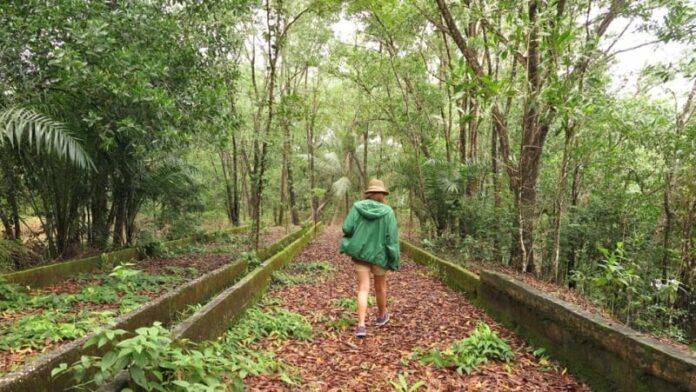Last year, I visited friends near Kalasin. Deep in the heart of Isan. Driving north past interminable paddy fields was a dispiriting experience. Barely ‒ and the adverb conveys a literal truth ‒ a tree in sight. Tight-fisted husbandry had meant their remorseless eradication, either because they siphoned up too much precious water, or because the space was needed for the main subsistence crop: rice.
Over 7 million hectares, half of Thailand’s arable land, supports the cultivation of rice. These neat rectangles of level terrain parceled into allotments and divided by the occasional ‘klong’, were stark reminders of the dominance of oryza sativa ‒ and the slide-rule mentality of those who must live and die by it.
Driving south to Trang recently was a very different experience. Phang Nga, awash in monsoon rains, was a verdant revelation. One passed deciduous and evergreen rain forests with endless vistas of trees. Massive jungle giants – rain trees, dipterocarps and tectonas – silhouetted above an endless, waving canopy of green where the smaller evergreens – dalbergias, elaeocarpuses and syzygiums – were draped in lush liana vines. Hardly a bare patch of land in sight.
True, much was secondary growth where nature had only recently recolonised barren tracts left by homo sapiens. And much, like the rice fields of the north, revealed the massive transmutation wrought by man’s heavy hand: huge pale green stands of slim-boled rubber trees (hevea brasiliensis), now locked in competition for their very commercial existence with invading battalions of oil palms (elaeis guineensis), their stout ferny trunks topped by massive dark green fronds. A formidable adversary. In fact, both are upstarts: rubber trees are native to Brazil; oil palms to West Africa. But in Southern Thailand they thrive better than in their native habitats.
And at least these relatively new kids on the block were trees, exhaling precious oxygen and offering some sort of haven for native wildlife. Even a section of road was a pleasure to drive along ‒ a stately avenue lined with towering dipterocarps, tectonas and alstonias ‒ serried ranks all standing rigidly to attention as we passed. Further south were roadside plantings of crape myrtles, their crinkly deep pink flowers just coming into bloom. Not for nothing is the lagerstroemia, known locally as ‘tree trang’.
Glimpsed dramatically through roadside clearings and towering above the seaside mangroves, were the karsts, calcium monoliths for which both Phang Nga and Krabi are famous: huge, precipitous slabs of limestone rising from the ultramarine sea and carved into fantastic shapes by salt and rain; their summits crowned with exotic orchids, perched precariously atop these unassailable monuments to nature.
Of course these impressions – and they are only fleeting ‘farang’ impressions – are all too black and white. Or to dispense with the cliché and use the actual colours of these contrasting landscapes, all too grey or green. Nonetheless, my abiding memory is of two worlds – one grey-brown and featureless, the other green and vibrant.
Of such contrasts is amazing Thailand made…
Patrick Campbell’s book ‘The Tropic Gardener’, described in one Bangkok review as the best book on Thai gardening for 50 years, is available for B500 (half price) to personal callers from 59/84 Soi Saiyuan 13 in Rawai (Tel: 076-61227 or 085-7827551).



